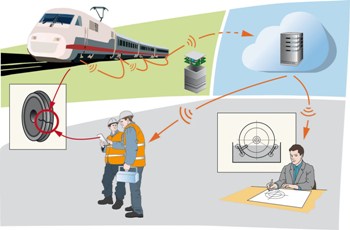Aug 1 2014
A new kind of human-machine communication is to make it possible to detect damage to rail vehicles before it’s too late and service trains only when they need it – all thanks to a cloud-supported, wireless network of sensors.
 Cloud-supported sensor network for the condition-based maintenance of rail vehicles. © Fraunhofer IZM
Cloud-supported sensor network for the condition-based maintenance of rail vehicles. © Fraunhofer IZM
A train running on damaged wheels could easily be heading for serious trouble. This is why German national rail corporation Deutsche Bahn continuously monitors the wheelsets of its intercity express trains – a process that costs a considerable amount of time and money. Researchers at the Berlin-based Fraunhofer Institute for Reliability and Microintegration IZM are collaborating with industry partners to develop a solution that ensures a great safety while reducing effort and cost. “We want to root out any damage early on and move away from maintenance at set intervals in favor of condition-based maintenance,” explains Dr. Michael Niedermayer, microsystems engineer and head of the IZM’s Technology-Oriented Design Methods working group. He is also project coordinator for “Mobile Sensor Systems for Condition-Based Maintenance,” or MoSe for short.
Seamless monitoring
It’s all based on a cloud-supported, wireless network of sensors. Every axle and undercarriage on a train is fitted with small radio sensors, which collect data on the condition of wearing parts. These data are then transferred to the online maintenance cloud, where the measurement and analysis data are encrypted and stored ready for use. The sensors can detect even the tiniest scratch on a ball bearing. As Niedermayer says, “Here we have sensor nodes that can capture even the slightest variations in vibration. We call this in-depth diagnosis.” As a result, repairs can be made before anything works its way loose and causes damage.
“What’s remarkable about this approach is that it allows everything to be monitored with the train in service, rather than having to inspect it at the rail yard. And in any case, visual checks are not 100 percent reliable,” says Manfred Deutzer from project partner Deutzer Technische Kohle GmbH. Although there are wired sensors out there that can be used to examine rail vehicle chassis for wear and tear, these fail to match the high diagnostic quality standards the MoSe developers are striving for.
Using the new method, it is possible to get precise data on, say, whether an axle bearing will have to be replaced three months down the line, which avoids the need to replace it prematurely just in case. The latter is just as uneconomical as the custom of overhauling wheels at preset intervals with a view to resolving any wheel flats that could damage rails. “Wheels can tolerate such repairs no more than three times before they have to be scrapped,” Deutzer reports. “It would make more sense and cost less to grind only those wheels we know actually turn poorly. The problem is that there has never been a suitable way of checking for wheel flats.” MoSe is to change all that and much more besides.
“Not only do we intend to improve diagnostics, a top priority is also to process the data collected in as detailed and tailored a manner as possible,” says Niedermayer. The idea is to provide train drivers with all relevant data (for instance about critical wheel damage), diagnostic technicians with detailed measurement data so they can assess how fast gear damage is progressing, and designers with measurement statistics covering wear to all parts, enabling them to improve the technical design of the next product generation. Making sure everyone involved receives the data they need in a form they can work with right away involves developing some clever diagnostic algorithms. “Yet another advantage is that wireless sensors can be easily retrofitted,” adds Niedermayer.
What’s also new is that the system can adapt to the different rotational speeds of the parts being examined – such as the wheels on a train – and in doing so, deliver incredibly precise data at whatever speed the train happens to be traveling. It used to be that sensors were designed to work at constant rotational speeds. Although this setup may be easier to manage, it means that the diagnostic quality suffers. Thanks to analysis algorithms, this is set to change. But developing these algorithms is a balancing act: “Since the system is intended to work without batteries, the algorithms mustn’t drain unnecessary energy by using up excessive computing power,” explains Niedermayer. As MoSe uses energy harvesting, it can tap energy from the vibrations and heat generated as the parts rotate.
Over the next couple of years a prototype will be developed that will be tested in a tram run by the German city of Brandenburg an der Havel. The system could then be used for monitoring purposes in suburban or long-distance trains.